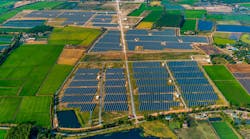What is the meaning of SWPPP?
The acronym “SWPPP” stands for Stormwater Pollution Prevention Plan. SWPPPs are commonly associated with construction and industrial stormwater permits.
A SWPPP is an overall site-specific plan to eliminate the water quality problems associated with stormwater and daily runoff on a construction site or project that disturbs runoff.
The plan may include the incorporation of any number of proprietary and nonproprietary best management practices (BMPs).[1]
What is a Stormwater Pollution Prevention Plan (SWPPP)?
A Stormwater Pollution Prevention Plan, or SWPPP, is a site-specific, written document that identifies potential sources of stormwater pollution at a construction site.
The document describes best practices to reduce pollutants in stormwater discharges from the construction site. Reduction of these pollutants is often achieved by controlling the volume of stormwater runoff.
The SWPPP also identifies procedures the operator (person in charge of the site) will implement to comply with the terms and conditions of a construction general permit.[2]
Who is the legally responsible person for SWPPP?
A SWPPP may be required and implemented prior to construction activities on a given site.
The property owner is considered the Legally Responsible Person (LRP) and is responsible for obtaining permit coverage.[3]
What is a qualified SWPPP developer?
A Qualified Stormwater Pollution Prevention Plan Developer (QSD) is a certified professional who is responsible for the initial development and oversight of SWPPPs.
QSD’s are trained to ensure compliance and effectiveness in a timely manner when it comes to developing a SWPPP. They possess the understanding of local regulatory requirements and can design effective pollution prevention measures for construction sites.[4]
What are common SWPPP objectives?
The main goal of a SWPPP is to ensure good water quality while working on a construction site.
Construction sites can disturb pollutants settled in the ground. Heavy rain and storms can pick up contaminants in stormwater runoff that lead to municipal sewer systems. Most municipalities have limits and pretreatment requirements for the runoff and pollutants that enter the local stormwater system. Some pollutants may be prohibited, and others require special permits or plans to be discharged.
SWPPPs and National Pollutant Discharge Elimination System (NPDES) permits are not always required for discharged pollutants that enter a municipal system, but facilities should check with their municipality or local water authority before discharging pollutants.[5]
Regulating facilities that discharge water containing pollutants is a step toward preserving and improving water quality.
What is a SWPPP called?
A SWPPP may be called different things based on location.
According to the U.S. Environmental Protection Agency (EPA) states may use terms like:
- Construction best practices plan
- Sediment and stormwater plan
- Erosion, sediment and pollution prevention plan
- Construction site best management practices plan
- Erosion control plan and best management practices
- Best management practices plan
- Erosion and sediment control plan
Who is responsible for controlling water pollution?
SWPPPs control water pollution, specifically stormwater runoff, on a particular site.
On a larger scale, the EPA carries the responsibility for ensuring the Clean Water Act (CWA) standards are being met. The CWA ensures that, at a federal/state level, that nation’s waters are being protected, restored and maintained.
Although the EPA is responsible for the CWA, it may be up to the states to administer the program.
At a more local level, industries, municipalities and individuals oversee the amount of water pollution that is generated. It is up to these entities to prevent water pollution by adhering to local regulations and best practices, such as SWPPPs.
Sources
[1] https://pw.lacounty.gov/general/faq/index.cfm?Action=getAnswers&FaqID=IyMtMzwK&Theme=default#:~:text=Answer%3A,Regional%20Water%20Quality%20Control%20Board.
[2] https://www.epa.gov/sites/default/files/2015-10/documents/sw_swppp_guide.pdf
[3] https://www.jbdenvironmental.com/services/storm-water-pollution-prevention-plan.php#:~:text=As%20part%20of%20complying%20with,responsible%20for%20obtaining%20permit%20coverage.
[4] https://www.pathlightpro.com/the-importance-of-working-with-a-qualified-swppp-developer/#:~:text=FAQs%3A%20Qualified%20SWPPP%20Developer&text=QSD%20stands%20for%20Qualified%20Stormwater,development%20and%20oversight%20of%20SWPPPs.
[5] https://www.newpig.com/what-is-a-swppp-stormwater-pollution-prevention-plan/c/8044#:~:text=The%20purpose%20of%20a%20SWPPP,containing%20small%20amounts%20of%20pollutants.
About the Author
Alex Cossin
Associate Editor
Alex Cossin is the associate editor for Waterworld Magazine, Wastewater Digest and Stormwater Solutions, which compose the Endeavor Business Media Water Group. Cossin graduated from Kent State University in 2018 with a Bachelor of Science in Journalism. Cossin can be reached at [email protected].


